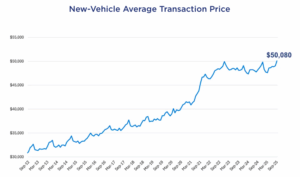Key Takeaways
The average price paid for a new vehicle in September topped $50,000 for the first time, as the removal of tax incentives for electric vehicles (EVs) at the end of that month drove strong EV sales.
Electric vehicles are more expensive than their traditional counterparts, with the average EV transaction price in September more than $58,000.
Tesla had the largest EV market share for the first nine months of the year at 43.1%, followed by GM with 13.8%.
EV sales are higher in China and Europe than in the United States because China is not well-endowed with oil resources, and Europe’s onerous climate regulations are phasing out petroleum-fueled vehicles in favor of EVs.
The average price paid for a new vehicle in September topped $50,000 for the first time ever, Cox Automotive’s Kelley Blue Book reported. While tariffs have increased costs and reduced affordability, the record prices in September were driven by strong sales of all-electric vehicles (EVs). Consumers rushed to buy EVs ahead of federal tax incentives of up to $7,500 ending at the end of September. EVs are more expensive than their traditional counterparts. The average transaction price for a new electric vehicle in September was more than $58,000. Besides higher sticker prices, new car buyers are seeing smaller discounts and higher loan rates since the coronavirus pandemic. The average new auto loan rate was about 9% as of the most recent data from August, according to Cox Automotive’s Dealertrack.

Via CNBC, U.S. sales of EVs, excluding hybrids, topped one million units through the first nine months of 2025, and set a new quarterly record of more than 438,000 units sold during the third quarter — achieving market share of 10.5% for the period — up from 7.4% during the second quarter and 7.6% during the first three months of the year. Sales of all-electric models were estimated to be 1.3 million in 2024, with about an 8% market share. Tesla had a 43.1% market share through September, down from 49% at the end of last year.

As reported by CNBC, GM, which offers the most EV models in the United States, has made significant gains this year, increasing its market share from 8.7% at the beginning of the year to 13.8% through the third quarter – topping Hyundai Motor, including Kia, at 8.6%. GM sold 144,668 EVs through September, representing 6.8% of its total U.S. sales. Ford Motor’s EV market share was 6.6% through the third quarter, followed by Volkswagen at 5.4%, Honda Motor at 4.6%, and BMW at 3.6%. Despite sales increasing each quarter of this year, EV startups Rivian Automotive and Lucid Group continue to have small EV market shares, with Lucid under 1% and Rivian at 3% through September.
The “One Big Beautiful Bill Act” removed the federal EV tax incentives, but included some perks for buying a U.S.-assembled vehicle, regardless of it being an electric vehicle. According to CNBC, once the bill was passed with the phase out of the EV tax credit imminent, sales of EVs quickly gained traction, especially as some automakers added more discounts to move out older models. The auto industry, however, will now need to adapt to the new federal environment, modifying plans for battery plants and EV capacity as the removal of EV tax incentives is likely to create a boom-and-bust cycle for the sale of electric vehicles.
Via CNBC, Ford CEO Jim Farley said he “wouldn’t be surprised” if sales of EVs fell from an industry market share of around 10% to 12% in September to 5% after the incentive program ends. The industry has learned that “partial electrification,” such as hybrids, is easier for customers to accept for the time being.
Globally, sales of EVs are higher than in the United States, as other countries are not as well-endowed with oil and gas resources as the United States. In Europe, states are obsessed with reaching net-zero carbon emissions by 2050, with onerous regulations pushing industries offshore. As reported by CNBC, the International Energy Agency found that China continued to lead EV adoption globally last year, with sales of 6.4 million all-electric vehicles, not counting hybrids, as China is not well endowed with oil resources but has low-cost electricity fueled primarily by coal. China’s EV market is followed by Europe’s at 2.2 million EV units, with its obsession to eliminate fossil fuels, its regulations phasing out petroleum-fueled vehicles, and its subsidies for electric vehicles.
Analysis
Without the generous subsidies gifted to EVs under the Inflation Reduction Act, EVs are expected to have trouble on the open market. While they may make more sense in countries like China, which lack significant oil reserves — especially if these countries develop substantial charging infrastructure — range concerns, battery cost, and depreciation make EVs more expensive than gas-powered cars. September’s higher average new vehicle price makes this fact clear.
For inquiries, please contact [email protected].



